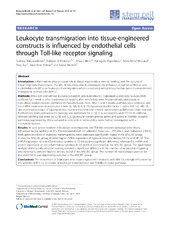| dc.contributor.author | Bartaula-Brevik, Sushma | en_US |
| dc.contributor.author | Pedersen, Torbjorn Østvik | en_US |
| dc.contributor.author | Blois, Anna L | en_US |
| dc.contributor.author | Papadakou, Panagiota | en_US |
| dc.contributor.author | Finne-Wistrand, Anna | en_US |
| dc.contributor.author | Xue, Ying | en_US |
| dc.contributor.author | Bolstad, Anne Isine | en_US |
| dc.contributor.author | Mustafa, Kamal Babikeir Eln | en_US |
| dc.date.accessioned | 2015-02-19T08:49:12Z | |
| dc.date.available | 2015-02-19T08:49:12Z | |
| dc.date.issued | 2014-12-20 | eng |
| dc.identifier.issn | 1757-6512 | |
| dc.identifier.uri | http://hdl.handle.net/1956/9407 | |
| dc.description.abstract | Introduction Inflammation plays a crucial role in tissue regeneration, wound healing, and the success of tissue-engineered constructs. The aim of this study was to investigate the influence of human umbilical vein endothelial cells (ECs) on leukocyte transmigration when co-cultured with primary human bone marrow-derived multipotent stromal cells (MSCs). Methods MSCs with and without ECs were cultured in poly (L-lactide-co-1, 5-dioxepan-2-one) (poly (LLA-co-DXO)) scaffolds for 1 week in vitro in a bioreactor system, after which they were implanted subcutaneously in non-obese diabetic/severe combined immunodeficient mice. After 1 and 3 weeks, scaffolds were retrieved, and the mRNA expression of interleukin 1-beta (IL-1β), IL-6, IL-10, hypoxia-inducible factor 1-alpha (HIF-1α), HIF-1β, and mammalian target of rapamycin was examined by real-time reverse transcription-polymerase chain reaction. Furthermore, immunofluorescent staining was performed for IL-1β, IL-6, neutrophils, and CD11b. In addition, Western blotting was done for IL-1β and IL-6. Leukocyte transmigration genes and genes in Toll-like receptor pathways, expressed by MSCs cultured in vitro with or without ECs, were further investigated with a microarray dataset. Results In vitro, genes involved in leukocyte transmigration and Toll-like receptor pathways were clearly influenced by the addition of ECs. Platelet/endothelial cell adhesion molecule-1 (PECAM-1) and cadherin-5 (CDH5), both genes involved in leukocyte transmigration, were expressed significantly higher in the MSC/EC group. In vivo, the MSC/EC group showed higher mRNA expression of hypoxia-inducible factors HIF-1α and HIF-1β. The mRNA expression of anti-inflammatory cytokine IL-10 showed no significant difference, whereas the mRNA and protein expression of pro-inflammatory cytokines IL-1β and IL-6 were lower in the MSC/EC group. The quantitative analysis of immunofluorescent staining revealed a significant difference in the number of neutrophils migrating into constructs, with the highest density found in the MSC/EC group. The number of macrophages positive for IL-6 and CD11b was significantly reduced in the MSC/EC group. Conclusions The recruitment of leukocytes into tissue-engineered constructs with MSCs is strongly influenced by the addition of ECs via activation of leukocyte transmigration and Toll-like receptor pathways. | en_US |
| dc.language.iso | eng | eng |
| dc.publisher | BioMed Central | eng |
| dc.relation.ispartof | <a href="http://hdl.handle.net/1956/15230" target="blank">Vascularization and Host Response in Bone Tissue Engineering</a> | |
| dc.rights | Attribution CC BY | eng |
| dc.rights.uri | http://creativecommons.org/licenses/by/4.0 | eng |
| dc.title | Leukocyte transmigration into tissue-engineered constructs is influenced by endothelial cells through Toll-like receptor signaling | en_US |
| dc.type | Peer reviewed | |
| dc.type | Journal article | |
| dc.date.updated | 2015-02-03T12:24:27Z | |
| dc.description.version | publishedVersion | en_US |
| dc.rights.holder | Copyright 2014 Bartaula-Brevik et al.; licensee BioMed Central. This is an Open Access article distributed under the terms of the Creative Commons Attribution License (http://creativecommons.org/licenses/by/4.0), which permits unrestricted use, distribution, and reproduction in any medium, provided the original work is properly credited. The Creative Commons Public Domain Dedication waiver (http://creativecommons.org/publicdomain/zero/1.0/) applies to the data made available in this article, unless otherwise stated. | |
| dc.rights.holder | Sushma Bartaula-Brevik et al.; licensee BioMed Central Ltd. | |
| dc.source.articlenumber | 143 | |
| dc.identifier.doi | https://doi.org/10.1186/scrt533 | |
| dc.identifier.cristin | 1188785 | |
| dc.source.journal | Stem Cell Research & Therapy | |
| dc.source.40 | 5 | |
| dc.source.14 | 6 | |

